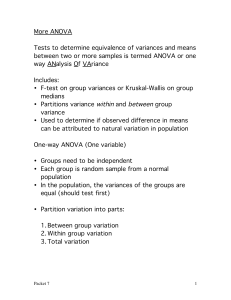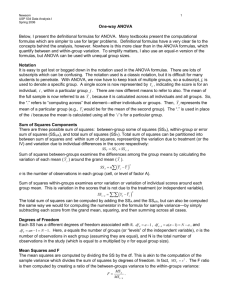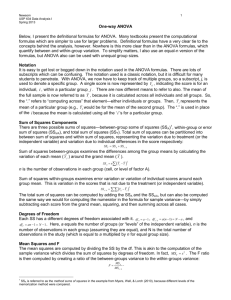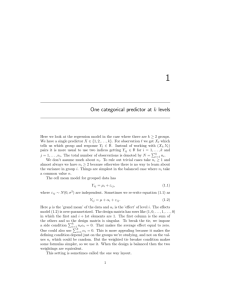( ) ∑∑ ∑
advertisement
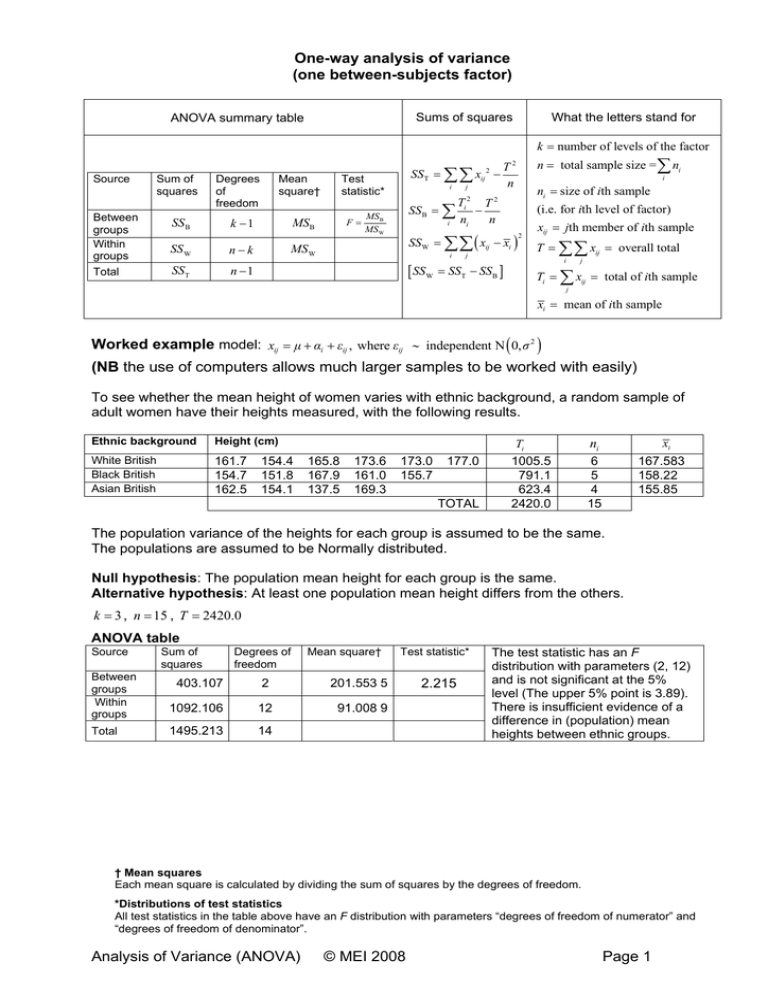
One-way analysis of variance (one between-subjects factor) Sums of squares ANOVA summary table What the letters stand for k = number of levels of the factor Source Between groups Within groups Total Sum of squares Degrees of freedom Mean square† SSB k −1 MSB SS W n−k MS W SST n −1 SST = ∑∑ xij 2 − Test statistic* F= i SS B = ∑ MS B MS W i j i ni = size of ith sample Ti 2 T 2 − ni n SSW = ∑∑ ( xij − xi ) i n = total sample size = ∑ ni T2 n j [ SSW = SST − SSB ] 2 (i.e. for ith level of factor) xij = jth member of ith sample T = ∑∑ xij = overall total i j Ti = ∑ xij = total of ith sample j xi = mean of ith sample Worked example model: xij = μ + αi + εij , where εij ∼ independent N ( 0, σ 2 ) (NB the use of computers allows much larger samples to be worked with easily) To see whether the mean height of women varies with ethnic background, a random sample of adult women have their heights measured, with the following results. Ethnic background Height (cm) White British Black British Asian British 161.7 154.7 162.5 154.4 151.8 154.1 165.8 167.9 137.5 173.6 161.0 169.3 173.0 155.7 177.0 TOTAL Ti 1005.5 791.1 623.4 2420.0 xi ni 6 5 4 15 167.583 158.22 155.85 The population variance of the heights for each group is assumed to be the same. The populations are assumed to be Normally distributed. Null hypothesis: The population mean height for each group is the same. Alternative hypothesis: At least one population mean height differs from the others. k = 3 , n = 15 , T = 2420.0 ANOVA table Source Between groups Within groups Total Sum of squares Degrees of freedom Mean square† 403.107 2 201.553 5 1092.106 12 91.008 9 1495.213 14 Test statistic* 2.215 The test statistic has an F distribution with parameters (2, 12) and is not significant at the 5% level (The upper 5% point is 3.89). There is insufficient evidence of a difference in (population) mean heights between ethnic groups. † Mean squares Each mean square is calculated by dividing the sum of squares by the degrees of freedom. *Distributions of test statistics All test statistics in the table above have an F distribution with parameters “degrees of freedom of numerator” and “degrees of freedom of denominator”. Analysis of Variance (ANOVA) © MEI 2008 Page 1 Two-way analysis of variance (no interaction) ANOVA summary table Source Sum of squares Degrees of freedom b −1 SSB Factor B SSR Residual n − a − b +1 SST = ∑∑∑ xijk Test statistic* MSA MSA F= MS R MSB MS B F= MSR i j k 2 SSB = ∑ j What the letters stand for a = number of levels of factor A T 2 b = number of levels of factor B − n r = number of data values for each T2 T2 SSA = ∑ i − n i rb MSR (by subtraction) Tj2 T2 − ra n combination of levels of A and B n = rab = total sample size xijk = kth member of sample at level i of factor A & level j of factor B T = ∑∑∑ xijk = overall total i j k SSR = SST − ( SS A + SSB ) Ti = total of data at level i of factor A Tj = total of data at level j of factor B n −1 SST Total Mean square† a −1 SSA Factor A Sums of squares Worked example model: xij = μ + αi + β j + εij , where εij ∼ independent N ( 0, σ 2 ) (NB the use of computers allows much larger samples to be worked with easily) Two laboratories test the calorific content of four brands of digestive biscuit. Three of each variety of biscuit are tested by each laboratory with the following results. The number of calories per biscuit is shown. Lab 1 Biscuit I Biscuit II Biscuit III Biscuit IV 73.6 69.3 75.8 71.1 Tj 72.2 67.6 75.7 66.7 74.3 70.1 76.4 69.8 862.6 Ti Lab 2 70.9 70.6 72.5 70.5 73.7 69.6 73.0 71.2 75.5 69.9 71.6 70.4 859.4 440.2 417.1 445.0 419.7 T = 1722 The population variance of the number of calories per biscuit is assumed to be the same for each combination of laboratory and biscuit brand. It is assumed that there is no interaction between the factors (see page 5 for “with interaction”). The populations are assumed to be Normally distributed. Null hypotheses: (a) The population mean number of calories per biscuit is the same for each brand. (b) The population mean number of calories per biscuit is the same for each of the laboratories. Alternative hypotheses: (a) At least one population mean calorie count differs from the other brands. (b) At least one population mean calorie count differs from the other laboratories. Factor A is biscuit brand. Factor B is laboratory. a = 4, b = 2, r = 3, n = 24 ANOVA table Source Factor A Factor B Residual Total Sum of Degrees of squares freedom 100.09 3 0.4267 1 52.703 19 153.22 23 Mean square† 33.363 0.4267 2.774 Test statistic* 12.03 0.154 The critical value for F3,19 at the 5% level is 3.13. 12.03 is bigger than this so there is evidence that not all brands of biscuit have the same population mean calorie count. The critical value for F1,19 at the 5% level is 4.38. 0.137 is less than this so there is no evidence of a difference between laboratories in respect of the population mean calorie count. † Mean squares Each mean square is calculated by dividing the sum of squares by the degrees of freedom. *Distributions of test statistics All test statistics in the table above have an F distribution with parameters “degrees of freedom of numerator” and “degrees of freedom of denominator”. Analysis of Variance (ANOVA) © MEI 2008 Page 2 Analysis of variance for randomised blocks ANOVA summary table Source Sum of squares Factor A (treatment) Factor B (blocks) Degrees of freedom Mean square † a −1 SSA b −1 SSB n − a − b +1 Residual SSR (by subtraction) Total SST n −1 Sums of squares Test statistic* MSA MS R MSA F= MSB MS B F= MSR SST = ∑∑∑ xijk 2 − i k SSA = ∑ Ti T 2 − rb n SSB = ∑ Tj i j MSR j What the letters stand for T n 2 2 2 ra − T2 n SSR = SST − ( SS A + SSB ) a = number of levels of factor A b = number of levels of factor B r = number of data values for each combination of levels of A and B n = rab = total sample size xijk = kth member of sample at level i of factor A & level j of factor B T = ∑∑∑ xijk = overall total i j k Ti = total of data at level i of factor A Tj = total of data at level j of factor B Worked example model: xij = μ + αi + β j + εij , where εij ∼ independent N ( 0, σ 2 ) (NB the use of computers allows much larger samples to be worked with easily) Four varieties of garden pea (C, D, E and F) are planted in a randomised block design in strips in a field which has a stream flowing down one side. The treatment factor is pea variety. The blocking (nuisance) factor is distance from the stream. The mean yield per plant (grammes) is shown in the table below. Pea C Pea D Pea E Pea F Tj Strip 1 Strip 2 Strip 3 294 324 322 263 1203 274 335 278 280 1167 305 256 286 285 1132 Ti 873 915 886 828 T =3502 The population variance of the mean yield is assumed to be the same for each combination of variety and strip. It is assumed that there is no interaction between the factors. The populations are assumed to be Normally distributed. a = 4, b = 3, r = 1, n = 12 . Null hypotheses: (a) The population mean yield is the same for each pea variety. (b) The population mean yield is the same for each strip. Alternative hypotheses: (a) At least one population mean yield for a variety differs from the other varieties. (b) At least one population mean yield for a strip differs from the other strips. ANOVA table Source Variety Strips Residual Total Sum of Degrees of squares freedom 1311 3 630.17 2 4980.5 6 6831.7 Mean square† 437 315.08 830.08 Test statistic* 0.526 0.3796 The critical value for F3,11 at the 5% level is 3.59. 0.526 is less than this so there is no evidence of a difference in population mean yield between pea varieties. 11 The critical value for F2,11 at the 5% level is 3.98. 0.3796 is less than this so there is no evidence of a difference between strips in respect of population mean yield. † Mean squares Each mean square is calculated by dividing the sum of squares by the degrees of freedom. *Distributions of test statistics All test statistics in the table above have an F distribution with parameters “degrees of freedom of numerator” and “degrees of freedom of denominator”. Analysis of Variance (ANOVA) © MEI 2008 Page 3 Analysis of variance for Latin square ANOVA summary table Source Sum of squares Degrees of freedom Mean square† Sums of squares Test statistic* MS rows F= MS R Rows SS rows n −1 MS rows Columns SScols n −1 MScols F= MScols MS R Treatments SS treats n −1 MS treats F= MS treats MSR Residual SSR Total SST (n − 1)(n − 2) MSR (by subtraction) T2 SST = ∑∑ xij − 2 n i j 2 SSrows = ∑ Tr T − n n2 SScols = ∑ Tc T − n n2 r c 2 2 What the letters stand for n = number of rows (or columns) xij = observation in row i and column j 2 T = ∑∑ xij = overall total i 2 j Tr = total of data in row r Tk 2 T 2 Tc = total of data in column c − n n2 k total of data at SSR = SST − ( SSrows + SScols + SS treats ) Tk = one level of the treatment SStreats = ∑ n2 − 1 Worked example model: xij ( k ) = μ + αi + β j + γk + εij ( k ) , where εij ( k ) ∼ independent N ( 0, σ 2 ) An experiment to test whether four varieties of potato give the same mean yield is carried out in a square field subdivided into a square grid of plots of equal size. It is thought that the field might have natural “fertility gradients” both across and down it. To allow for this possibility, a Latin square design is used. The table shows the layout of the field and the yield in kg per plot. The rows and columns represent the possible fertility gradients (these are nuisance factors). The letters A, B, C, D represent the varieties of potato (the factor of interest). n = 4. A D B C Col Total 19.8 21.3 20.8 20.4 82.3 B A C D 21.2 21.0 18.3 16.1 76.6 D C A B 22.0 18.8 20.7 18.4 79.9 C B D A 18.6 18.7 17.1 14.3 68.7 Row Total 81.6 79.8 76.9 69.2 307.5 Variety A B C D Total Total 75.8 79.1 76.1 76.5 307.5 Null hypotheses: (a) The population mean yield is the same for all varieties. (b) The population mean yield is the same in each row (i.e. no fertility gradient in this direction). (c) The population mean yield is the same in each column (i.e. no fertility gradient in this direction) Alternative hypotheses: Each null hypothesis has a corresponding alternative hypothesis that at least one population mean yield differs from the others ANOVA table Source Rows Columns Treatments (varieties) Residual Total Sum of Degrees of squares freedom 22.447 3 26.372 3 Mean square† 7.482 8.791 1.712 3 0.571 15.814 6 2.636 66.344 15 Test statistic* 2.839 3.335 0.217 The critical value for F3,6 at the 5% level is 4.76. 2.839 and 3.335 are each smaller than 4.76 so there is no evidence of a significant difference in mean yields between rows or columns 0.217 is also smaller than 4.76 so there is no evidence of difference in mean yield between varieties. NOTE The Latin square is also useful for situations where there are two “real-interest” factors and one “nuisance” or three “real-interest” factors, provided all factors have the same number of levels and there is no interaction. Simply use the rows and/or columns to represent the additional real-interest factor(s). † Mean squares Each mean square is calculated by dividing the sum of squares by the degrees of freedom. *Distributions of test statistics All test statistics in the table above have an F distribution with parameters “degrees of freedom of numerator” and “degrees of freedom of denominator”. Analysis of Variance (ANOVA) © MEI 2008 Page 4 Two-way analysis of variance (with interaction) (two between-subjects factors) ANOVA summary table Sums of squares What the letters stand for a = number of levels of factor A b = number of levels of factor B n = total sample size Source Sum of squares Degrees of freedom Mean square † Test statistic* Factor A SSA a −1 MSA MSA F= MS R Factor B SSB b −1 MSB F= MS B MSR A×B interaction SSAB MS AB F= MS AB MS R Residual SSR (by subtraction) Total SST n −1 (a − 1)(b − 1) n − ab MSR SST = ∑∑∑ xijk i SSA = ∑ j k 2 T2 − n Ti 2 T 2 − ni n xijk = kth member of sample at level i of factor A & level j of factor B T = ∑∑∑ xijk = overall total i j k Ti = total of data at level i of factor A Tj 2 T 2 SSB = ∑ − ni = number of data items n j nj at level i of factor A Tg 2 T 2 Tj = total of data SSG = ∑ − at level j of factor B n g ng n = number of data items j SSAB = SSG − ( SSA + SSB ) at level j of factor B SS R = SS T − ( SS A + SS B + SS AB ) Tg = total of all the data at a particular level i of A and of B (there are ab such groups) ng = number of data values at a particular level of A and of B Worked example model: xijk = μ + αi + β j + γij + εijk , where εijk ∼ independent N ( 0, σ 2 ) (NB the use of computers allows much larger samples to be worked with easily) In an experiment to test whether students achieve similar marks on computer based tests to those they achieve on paper based tests, a random sample of students from three classes sit either a paper based or a computer based test (the questions on both tests are the same). The marks they achieve are shown: Class Class 2 Class 1 Computer Test mode Paper Class totals 33 38 61 69 Total 201 53 47 36 47 Total 183 384 62 57 63 41 Total 223 37 42 45 52 Total 176 399 Class 3 62 44 39 45 Total 190 30 42 27 35 Total 134 324 Test mode totals 614 493 1107 The variance for each section of the population is assumed to be the same. The population is assumed normal. Factor A is “test mode”; this is the factor of interest. Factor B is “class”; this is a nuisance factor. a = 2, b = 3, n = 24, ni = 12 (all i ), n j = 8 (all j ), ng = 4 (all g ) . See next page for ANOVA table and conclusion. † Mean squares Each mean square is calculated by dividing the sum of squares by the degrees of freedom. *Distributions of test statistics All test statistics in the table above have an F distribution with parameters “degrees of freedom of numerator” and “degrees of freedom of denominator”. Analysis of Variance (ANOVA) © MEI 2008 Page 5 ANOVA table for two-way analysis of variance (two between-subjects factors) Null hypotheses: (a) The population mean test mark is the same for either mode of test (paper or computer). (b) The population mean test mark is the same for each of the classes (c) There is no interaction between test mode and class in respect of the population mean test mark. Alternative hypothesis: (a) The population mean test marks differ for the test modes. (b) At least one population mean test mark differs from the other classes. (c) There is some interaction between test mode and class in respect of the population mean test mark. Source Sum of squares Degrees of freedom Mean square† Test statistic* Distribution of test statistic Critical value at 5% level Test mode 610.04 1 610.04 5.706 F1,18 4.41 Class 393.75 2 196.875 1.842 F2,18 3.55 0.461 F2,18 3.55 A×B interaction Residual Total 98.585 2 1924.25 3026.625 18 23 49.2925 106.903 SSG = 1102.375 5.706 > 4.41 so there is evidence that there is a difference in the mean marks for different modes of test. 1.842 < 3.55 so there is no evidence of difference in mean marks between the classes. 0.461 < 3.55 so there is no evidence of interaction between class and mode of test. † Mean squares Each mean square is calculated by dividing the sum of squares by the degrees of freedom. *Distributions of test statistics All test statistics in the table above have an F distribution with parameters “degrees of freedom of numerator” and “degrees of freedom of denominator”. Analysis of Variance (ANOVA) © MEI 2008 Page 6 Kruskal-Wallis one-way analysis of variance Calculation of test statistic Rank all data values, sum the ranks for each group and square these values. Test statistic, H, is: 2 12 ⎛ R j H= ⎜∑ N ( N + 1) ⎜⎝ N j Distribution of test statistic What the letters stand for ⎞ ⎟⎟ − 3( N + 1) ⎠ N j = size of sample j , N = ∑ N j , χ K2 −1 R j = sum of ranks for sample j K = number of groups Worked example (NB the use of computers allows much larger samples to be worked with easily) An investigation compares customer waiting times in three branches of a bank. The queuing time of a random sample of customers in each branch is measured with the following results (in minutes). Branch A B C Waiting times (mins) 0 0 2.9 7.3 0.9 0.7 8.4 4.4 0.8 8.2 2.4 7.0 0 4.0 0.3 6.0 Null hypothesis: The mean waiting times for all three branches are the same. Alternative hypothesis: The mean waiting times for all three branches are not the same. Ranks in bold Branch Waiting times (mins) 0 2 7.3 14 8.4 16 A B C N = 16, 0 2 0.9 7 4.4 11 2.9 9 0.7 5 0.8 6 8.2 15 2.4 8 7.0 13 0 2 4.0 10 0.3 4 6.0 12 Sum of ranks ( Rj ) Size of sample ( Nj ) 42 44 50 6 5 5 K =3 ⎞ ⎟⎟ − 3( N + 1) ⎠ 2 12 ⎛ 42 442 502 ⎞ H= + + ⎜ ⎟ − 3 × 17 16 × 17 ⎝ 6 5 5 ⎠ H ≈ 1.1118 H= 2 12 ⎛ R j ⎜⎜ ∑ N ( N + 1) ⎝ N j The 5% critical value for χ 22 is 5.991. 1.1118 < 5.991 so there is insufficient evidence, at the 5% level, that there is any difference in mean waiting times between the three branches. Analysis of Variance (ANOVA) Page 7 Friedman’s two-way analysis of variance by rank Calculation of test statistic N = size of each sample (number of data items in each column), K = number of samples (number of data items in each row), Put the data in a table. To test whether there is a significant difference between the sets of data in the columns, rank each row and sum the ranks for each column. Test statistic, M, is: M= Distribution of test statistic What the letters stand for Ri = sum of ranks for sample i K 12 ∑ Ri2 − 3N ( K + 1) NK ( K + 1) i =1 χ K2 −1 (sum of ranks of column i ) Worked example Five judges give a mark out of 15 to each of three paintings. Is there a significant difference between the judges? Judge Painting sunset 1 sunset 2 sunrise A B C D E 7 9 13 5 8 13 8 10 14 6 8 13 9 11 13 Null hypothesis: There is no significant difference between the judges. Alternative hypothesis: There is a significant difference between the judges. The factor of interest is whether the judges agree. The “nuisance” factor is “painting”. Ranking the rows Judge Painting sunset 1 sunset 2 sunrise rank sum A 7 9 13 3 3 2.5 8.5 B 5 1 8 1.5 13 2.5 5 C 8 10 14 4 4 5 13 D 6 2 8 1.5 13 2.5 6 E 9 11 13 5 5 2.5 12.5 N = 3, K = 5 K 12 M= ∑ Ri2 − 3N ( K + 1) NK ( K + 1) i =1 12 M= ( 8.52 + 52 + 132 + 62 + 12.52 ) − 3 × 3 × 6 3× 5 × 6 M = 7.13 The critical value at the 5% level for χ 42 is 9.488. 7.13 < 9.488 so there is insufficient evidence of a significant difference in the marks given by the five judges. Analysis of Variance (ANOVA) Page 8


